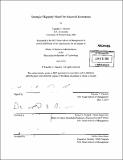| dc.contributor.advisor | Robert S. Pindyck. | en_US |
| dc.contributor.author | Daniels, Timothy C. (Timothy Craig) | en_US |
| dc.contributor.other | Sloan School of Management. | en_US |
| dc.date.accessioned | 2010-10-12T16:22:30Z | |
| dc.date.available | 2010-10-12T16:22:30Z | |
| dc.date.issued | 2010 | en_US |
| dc.identifier.uri | http://hdl.handle.net/1721.1/59119 | |
| dc.description | Thesis (M.B.A.)--Massachusetts Institute of Technology, Sloan School of Management, 2010. | en_US |
| dc.description | "June 2010." Cataloged from PDF version of thesis. | en_US |
| dc.description.abstract | Several years ago, Professor Robert Pindyck of the MIT Sloan School of Management created an oligopoly strategy game for use in his course 15.013: Industrial Economics for Strategic Decisions. This game divided the class up into "firms" (generally consisting of two students each) and randomly formed industries, each consisting of three firms. Students competed throughout the semester in a fictitious market for a heterogeneous good, each firm providing price and production inputs on a weekly basis. The purpose of the game was to provide a hands-on tool to teach students how industry competitors interact, and how forces such as signaling, collusion, demand fluctuations, and emotion affect industry and firm performance. Although the game was carried out successfully for several years, issues surfaced over time. In particular, the Excel model used to run the weekly calculations was set up awkwardly and was therefore difficult to use. Additionally, the memo distributed to students to explain the game was disorganized, lacked sufficient examples, and contained errors. Finally, Professor Pindyck desired to implement the game in other courses with other professors, and this was not possible without a thorough document containing instructions for running the game as well as in-depth background information on the theory behind the calculations. The work carried out for this thesis aimed to fix these problems. Specifically, I rebuilt the Excel model to operate in a simpler and more user-friendly fashion. Additionally, I revised the student memo to rectify the issues described above. Finally, I created a new manual to allow professors and TAs run the game in their courses. | en_US |
| dc.description.statementofresponsibility | by Timothy C. Daniels | en_US |
| dc.format.extent | 10, 8, 20, 34 p. | en_US |
| dc.language.iso | eng | en_US |
| dc.publisher | Massachusetts Institute of Technology | en_US |
| dc.rights | M.I.T. theses are protected by
copyright. They may be viewed from this source for any purpose, but
reproduction or distribution in any format is prohibited without written
permission. See provided URL for inquiries about permission. | en_US |
| dc.rights.uri | http://dspace.mit.edu/handle/1721.1/7582 | en_US |
| dc.subject | Sloan School of Management. | en_US |
| dc.title | Strategic oligopoly model for industrial economics | en_US |
| dc.type | Thesis | en_US |
| dc.description.degree | M.B.A. | en_US |
| dc.contributor.department | Sloan School of Management | |
| dc.identifier.oclc | 658826578 | en_US |
